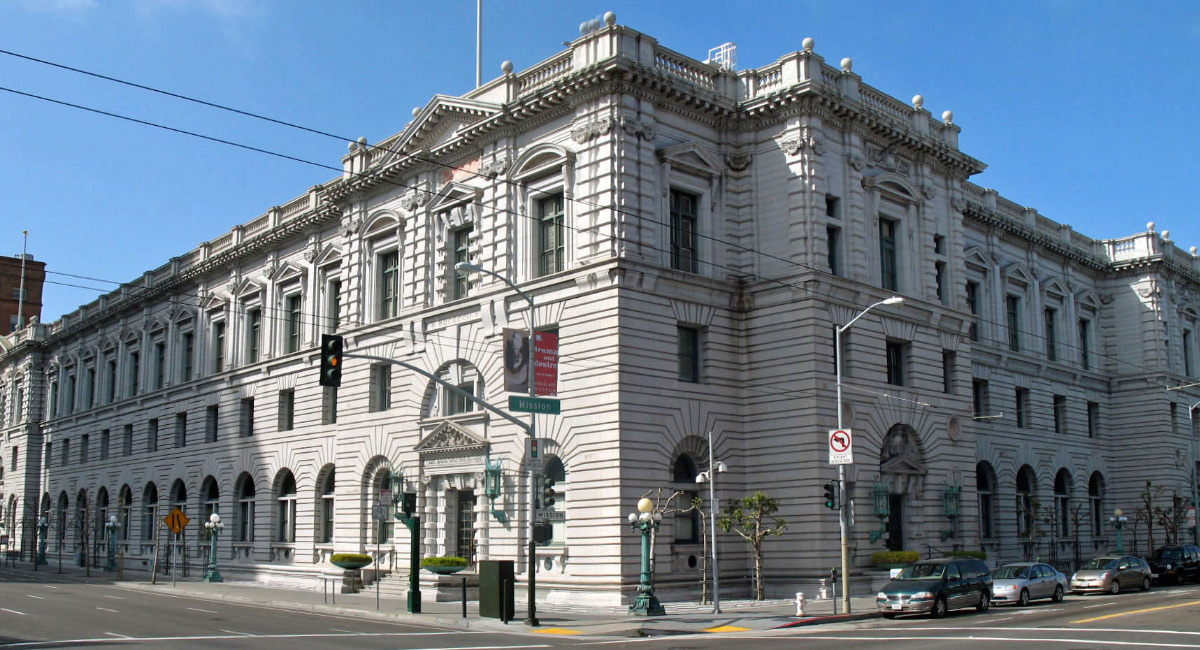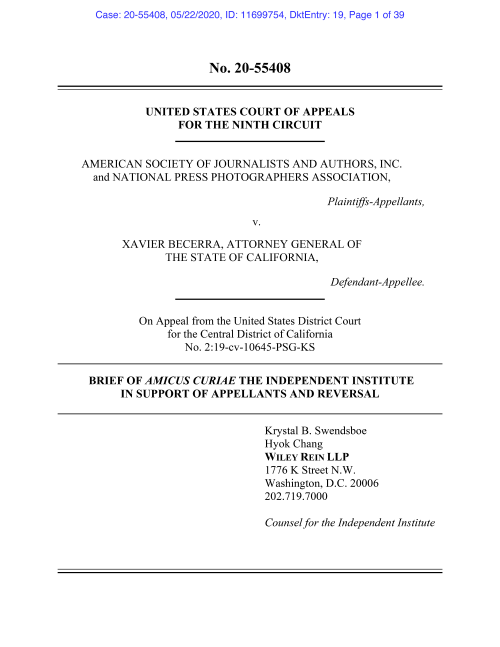Brief of Amicus Curiae by the Independent Institute in Support of the Appellants and Reversal in American Society of Journalists and Authors, Inc. and National Press Photographers Association v. Xavier Becerra, Attorney General of the State of California on Appeal from the U.S. District Court for the Central District of California.
In the guise of protecting workers, California’s relatively new AB-5 law cuts the economic foundation out from under at least a million Californians who had been making a living as freelance independent contractors (or “gig” workers).
Passed by the California Legislature and signed into law by Governor Gavin C. Newsom in September 2019, Assembly Bill 5 (AB-5) went into effect on January 1, 2020. By changing the rules, AB-5 forces freelancers into an untenable position: their clients have to either hire freelancers as employees, or drastically reduce their paid gigs—or else drop them altogether.
It is no secret that this legal change has had devastating consequences for California workers. Not surprisingly, some of them have sued to protect their right to make a living, through their gigs and the standalone businesses they have built.
The Independent Institute has weighed in on their behalf in a key legal case that is now before the federal Ninth Circuit Court of Appeals, American Society of Journalists and Authors, et al. v. Becerra (Xavier Becerra is California’s Attorney General).
The appellants in this case (freelance writers, editors, video-, and photo-journalists) argue that AB-5 infringes their free speech rights, and Independent’s amicus brief demonstrates that AB-5 is an irrational law that draws arbitrary and discriminatory lines through every industry and causes devastating harm to low- and middle-income workers. Indeed, while AB-5’s advocates purport to support the middle class, the law strips that group of the ability to pursue meaningful and flexible employment as independent contractors. Further, AB-5 is having widespread consequences for California’s economy as it removes desperately needed employment flexibility from the labor market.
Independent’s scholars have been actively analyzing AB-5 over the past year. This culminated in Independent’s Open Letter to Suspend California AB-5, directed by Senior Fellow Dr. Williamson M. Evers and signed by 153 economists and political scientists from across California. The letter was delivered to Governor Newsom and all members of the California Legislature. Independent believes that its expertise regarding AB-5 will be of particular assistance to the Court because, as the California Legislative Analyst’s Office advised, it is difficult to obtain empirical data representing the true extent of the harm caused by AB-5, due to its recent enactment (see The 2020-21 Budget: Staffing to Address New Independent Contractor Test).
Among other flaws, the statute arbitrarily discriminates between workers who perform virtually identical tasks. Its exemptions are invidious, allowing high-income, politically-favored professions to escape its job-killing mandates. In so doing AB-5 contravenes the Fourteenth Amendment’s guarantee of equal protection and the First Amendment’s guarantees of free speech and press. The appellants are therefore correct that AB-5’s limitations on freelance, video-, and photo-journalism fail strict scrutiny. But even if the Court were to apply what courts call the rational basis standard, AB-5 must be enjoined because its classifications are wholly arbitrary.
As a result, AB-5 cannot withstand any level of constitutional scrutiny. Further, this case demonstrates how rational basis review—the test typically applied to laws that restrict economic liberty—is misapplied and often fails to protect important economic liberties. Our constitutional system relies on courts to uphold the Constitution and to impose meaningful scrutiny of state legislation. The district court failed to do so here, and the Ninth Circuit judges must correct this misapplication of the law.
Bibliography
Abraham, Katharine G., John C. Haltiwanger, Kristin Sandusky and James R. Spletzer. 2018. Measuring the Gig Economy: Current Knowledge and Open Issues. National Bureau of Economic Research Working Paper 24950 (August).
Angrist, Joshua D., Sydnee Caldwell and Jonathan V. Hall. 2017. Uber vs. Taxi: A Driver’s Eye View. National Bureau of Economic Research Working Paper 23891 (October).
Beaudreau, Bernard C. and Jason E. Taylor. 2018. Why Did the Roosevelt Administration Think Cartels, Higher Wages, and Shorter Workweeks Would Promote Recovery from the Great Depression? The Independent Review, vol. 23, no. 1 (Summer): 91–107.
Bernal-Verdugo, Lorenzo E., Davide Furceri, and Dominique M. Guillaume. 2012. Labor Market Flexibility and Unemployment: New Empirical Evidence of Static and Dynamic Effects. International Monetary Fund Working Paper 12/64 (March 1).
Bernhardt, Annette and Sarah Thomason. 2017. What Do We Know About Gig Work in California? An Analysis of Independent Contracting. UC Berkeley Center for Labor Research and Education (June 14).
Bhuiyan, Johana. 2020. Coronavirus is supercharging the fight over California’s new employment law. Los Angeles Times (March 26, 2020).
Billingsley, K. Lloyd. 2020. How California’s AB-5 Hinders Coronavirus Response. The Beacon, Independent Institute (April 1).
__________. 2020. Protestors Rail Against California’s New Restrictions on Freelancers and the Gig Economy. The Beacon, Independent Institute (February 5).
Boeri, Tito, Giulia Giupponi, Alan B. Krueger and Stephen Machin. 2020. Solo Self-Employment and Alternative Work Arrangements: A Cross-Country Perspective on the Changing Composition of Jobs. Journal of Economic Perspectives, vol. 34, no. 1 (Winter): 170–195.
Bordo, Michael D., Christopher J. Erceg and Charles L. Evans. 2000. Money, Sticky Wages, and the Great Depression. The American Economic Review, vol. 90, no. 5 (December): 1447–1463.
Botero, Juan C., Simeon Djankov, Rafeal La Porta, Florencio Lopez-de-Silanes and Andrei Shleifer. 2004. The Regulation of Labor. The Quarterly Journal of Economics, vol. 119, no. 4 (November): 1339–1382.
Chen, M. Keith, Judith A. Chevalier, Peter E. Rossi and Emily Oehlsen. 2019. The Value of Flexible Work: Evidence from Uber Drivers. Journal of Political Economy, vol. 127, no. 6 (December): 2735–2794.
Cole, Harold. L. and Lee E. Ohanian. 2004. New Deal Policies and the Persistence of the Great Depression: A General Equilibrium Analysis. Journal of Political Economy, vol. 112, no. 4 (August): 779-816.
Donovan, Sarah A., David H. Bradley, and Jon Q. Shimabukuro. 2016. What Does the Gig Economy Mean for Workers? Congressional Research Service 7-5700, No. R44365 (February 5).
Edelman Intelligence. 2019. Freelancing in America: 2019. Upwork (September 23).
Edison Research. 2018. The Gig Economy. Marketplace-Edison Research Poll (December).
Epstein, Richard A. 2019. The Regulatory Hour: The History, Law and Economics of Minimum Wage and Maximum Hours Legislation, New York University Journal of Law & Liberty, vol. 12: 477–559.
Farren, Michael D. 2019. California’s Assembly Bill 5 Shows How Good Intentions Can Lead to Bad Consequences. The Bridge (October 8).
Feldmann, Horst. 2007. Economic Freedom and Unemployment around the World. Southern Economic Journal, vol. 74, no. 1 (July): 158–176.
Gereben, Janos. 2020. Some Musicians May Get Relief from the Onerous Strictures of AB5 Law. San Francisco Classical Voice (April 21).
Hall, Jonathan V. and Alan B. Krueger. 2018. An Analysis of the Labor Market for Uber’s Driver-Partners in the United States. ILR Review, vol. 71, no. 3 (May): 705–732
Harris, Seth D. and Alan B. Krueger. 2015. A Proposal for Modernizing Labor Laws for 21st Century Work: The "Independent Worker". Washington, DC: Brookings Institution Policy Brief 2015-10 (December 8).
Higgs, Robert. [1987] 2012. Crisis and Leviathan: Critical Episodes in the Growth of American Government, 25th Anniversary Edition. Oakland, CA: Independent Institute.
__________. [2006] 2009. Depression, War and Cold War: Challenging the Myths of Conflict and Prosperity. Oakland, CA: Independent Institute.
Holmes, Thomas, J. 1998. The Effect of State Policies on the Location of Manufacturing: Evidence from State Borders. Journal of Political Economy, vol. 106, no. 4 (August): 667-705.
Hussain, Suhauna. 2019. Vox Media cuts hundreds of freelance journalists as AB 5 changes loom, Los Angeles Times (December 17).
Hyman, Louis. 2020. California’s new gig economy law was meant to help workers. But it will likely hurt them instead. CNN Business Perspectives (January 9).
Independent Institute. 2020. Open Letter to Suspend California AB-5. (April 14).
Katz, Lawrence F. and Alan B. Krueger. 2016. The Rise and Nature of Alternative Work Arrangements in the United States, 1995-2015. National Bureau of Economic Research Working Paper 22667 (September).
Kilkenny, Katie. 2019. “Everybody Is Freaking Out”: Freelance Writers Scramble to Make Sense of New California Law. Hollywood Reporter (October 17, 10:34 a.m.).
Ladan, Luka. 2019. If the Gig Economy has Unintended Consequences, So Does Shutting It Down. Catalyst, Independent Institute (August 14).
Lin, Judy. 2019. Who’s in, who’s out of AB 5? Cal Matters (September 11).
MacKenzie, Douglas W. 2010. Industrial Employment and the Policies of Herbert C. Hoover. The Quarterly Journal of Austrian Economics, vol. 13, no. 3 (Fall): 101–119.
Mishel, Lawrence and Heidi Shierholz. 2011. Sustained, High Joblessness Causes Lasting Damage to Wages, Benefits, Income, and Wealth. Economic Policy Institute Briefing Paper 324 (August 31).
Munger, Michael C. 2018. Tomorrow 3.0: Transaction Costs and the Sharing Economy. New York: Cambridge University Press.
Oh, Rachel. 2019. From interpreters and journalists to pet sitters, California’s gig economy law has independent contractors fretting. Peninsula Press (December 23).
Ohanian, Lee E. 2020. California Lawmakers Unwittingly Make Surgery Much More Dangerous. California on Your Mind, Hoover Institution (April 7).
__________. 2009. What—or Who—Started the Great Depression? Journal of Economic Theory, vol. 144, no. 6 (November): 2310–2335.
Oranburg, Seth C. 2019. Unbundling Employment: Flexible Benefits for the Gig Economy. Drexel Law Review, vol. 11, no. 1: 1–58.
Palagashvili, Liya. 2018. Disrupting Employee and Contractor Laws. University of Chicago Legal Forum, vol. 2017, article 15 (February 5): 379–408.
Powell, Jim. 2003. FDR’s Folly: How Roosevelt and His New Deal Prolonged the Depression. New York: Crown Forum.
Pulliam, Mark S. 2019/20. The Exploitation of Labor and Other Union Myths. The Independent Review, vol. 24, no. 3 (Winter): 409–431.
Randle, Aaron. 2020. ‘I Feel Like a Hero’: A Day in the Life of a Grocery Delivery Man. New York Times (May 18).
Ring, Edward. 2019. The Many Unintended Consequences of AB 5. California Globe (December 10, 8:58 p.m.).
Rose, Jonathan D. 2010. Hoover’s Truce: Wage Rigidity in the Onset of the Great Depression. The Journal of Economic History, vol. 70, no. 4 (December): 843–870.
Rosenberg, Eli. 2020. Can California rein in tech’s gig platforms? A primer on the bold state law that will try. The Washington Post (January 14, 10:32 a.m.).
Said, Carolyn. 2020. Court: Instacart likely to flunk AB5, so shoppers would become employees. San Francisco Chronicle (February 25, 3:44 p.m.).
Seltzer, Andrew. 1997. The Effects of the Fair Labor Standards Act of 1938 on the Southern Seamless Hosiery and Lumber Industries. Journal of Economic History, vol. 57, no. 2 (June): 396–415.
Siebert, Horst. 1997. Labor Market Rigidities: At the Root of Unemployment in Europe. Journal of Economic Perspectives, vol. 11, no. 3 (Summer): 37–54.
Sumner, Scott. 2015. The Midas Paradox: Financial Markets, Government Policy Shocks, and the Great Depression. Oakland, CA: Independent Institute.
Taylor, Jason E. 2019. Deconstructing the Monolith: The Microeconomics of the National Industrial Recovery Act of 1933. Chicago: University of Chicago Press.
Taylor, Jason E., Todd C. Neumann, and Jerry L. Taylor. 2012. The Behavior of the Labor Market Between Schechter (1935) and Jones & Laughlin (1937). The Cato Journal, vol. 32, no 3 (Fall): 605–627.
__________. 2013. The Effect of Institutional Regime Change Within the New Deal on Industrial Output and Labor Markets. Explorations in Economic History, vol. 50, no. 4 (October): 582–598.
__________. 2016. Recovery Spring, Faltering Fall: March to November 1933. Explorations in Economic History, vol. 61 (July): 54–67.
Vedder, Richard K. and Lowell E. Gallaway. [1993] 1997. Out of Work: Unemployment and Government in Twentieth-Century America, Updated Edition. New York: New York University Press for the Independent Institute.
The White House. 2015. Occupational Licensing: A Framework for Policymakers. U.S. Department of the Treasury Office of Economic Policy, Council of Economic Advisors and the U.S. Department of Labor.










